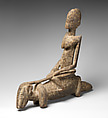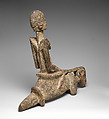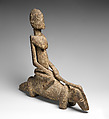Rider Figure on Quadruped
Not on view
This intimately scaled wooden sculpture depicts a seated figure riding on the back of an unsaddled quadruped. In alternating rounded volumes with more angular shapes, the sculptor defined the human and zoomorphic figures along a vertical and a horizontal axis that dominate the composition. With its bust slightly leaning back, the rider features a steady and composed stance while holding the single-rein bridle with the left hand—the right resting on the thigh. The head, also upright and facing forward, is covered with organic material that conceals the essential features visible in the contours of the forehead, ears and chin. Protruding up and forward, shoulders and breasts are sculpted as a unit that is set off from the more rounded abdomen, from which hips and thighs jut out, providing this figure a powerfully syncopated profile. The sharp definition of the torso is continued in the treatment of the back that is articulated along a straight spinal cord and pointed shoulder blades. The thin legs are flexed with the knees to touch and calves to hold onto the quadruped’s sides. Comparable in scale to its rider, the animal appears static, with its legs sculpted in a vertical position. The sculptor’s rendition of the animal’s rounded and bulging back, short and stumpy legs, thick and pointed tail, and small head has intrigued scholars who have not agreed on its identification. While the inclusion of the reins suggest that this is a domesticated quadruped, tamed by its rider, its morphology makes it resemble less a horse than other mammals such as a hippopotamus or a reptile such as the crocodile (Bouloré 2000: 86).
This work is attributed to the Tellem or Dogon peoples, who lived in the Bandiagara Escarpment in the Mopti region of central Mali as early as the 11th century. European ethnographers and colonial officers have travelled to this region as early as 1905 when French Lieutenant Louis Desplagnes began documenting the history of the Tellem and Dogon peoples. The first extensive ethnological and anthropological survey dates to Marcel Griaule’s famous Dakar-Djibouti mission (1931–33). While Griaule’s methodology and research have been challenged particularly since the early 1990s, his anthropological study offers important insights into the Dogon society and their sophisticated culture (Van Beek, 1991). Starting in 1964, architect Herman Haan and archeologist Rogier Bedaux have led interdisciplinary studies employing a variety of scientific approaches to better understand these populations’ rich histories and cultures (Bedaux, 1972). Recently, geochemist analysis has confirmed that before the arrival of the Dogon people to the Bandiagara Cliff in two successive waves in the 13th and the 15th century, a Pre-Dogon population with a different and distinct genetic profile had been inhabiting this area since the 11th century and had disappeared in the 16th century (Maurer et al. 2017: 291). Sculptures such as the Met rider figure was most likely produced in the intermediary phase, when the Pre-Dogon population—the Tellem—lived side-by-side with the Dogon, sharing and influencing each other’s cultural practices while continuing to participate in a wide social network as the presence of Asian glass beads suggests (Maurer et al. 2017: 290). The sculpture’s formal features and subject matter can in fact be related to both artistic traditions of the Tellem and the Dogon, further indicating these peoples’ shared and syncretic histories (for more information on the distinction between Tellem and Dogon see: 1979.206.64).
The work’s principle protagonist, the rider, is among the most important archetypes depicted by sculptors across the region. Art historians Herbert Cole and Ezio Bassani have agreed that such representations are usually associated with individuals imbued with power, whether military, political, economic or spiritual (Cole, 1983: 3; Bassani, 1995: 9-10). Within this typology, a human figure is represented mounting a quadruped, in most cases a horse, whose presence in the region has been documented as early as the 11th century with the birth of West Africa’s great medieval empires (Bassani, 1995: 9). While these objects evince the sitter’s social prestige and exceptional capabilities, their specific significance—in terms of formal qualities, ritual practices, and figures’ identities—greatly varied across and within cultural groups. Only within the extraordinary corpus of Dogon sculpture is the representation of the rider rendered across media, ranging from wood to brass, and is evoked in a variety of forms including rings (1981.425.1, 1977.394.73), free standing sculptures (1979.206.85), and ritual vessels (1979.206.255).
Ethnographic accounts collected in the 20th century give us a glimpse of these sculptures’ varied uses and rich significance among the Dogon. In 1907, Desplagnes documented that one such wooden equestrian figure belonged to a hogon, the spiritual, political, and judicial leader in Dogon communities (Desplagnes 1907: 321). In his elaborate exegesis of Dogon myths, Griaule mentions the presence of an ark with a horse’s head, suggesting this animal’s importance in local accounts of genesis (Griaule 1951: 28-9 and see 1979.206.255). In 1935, during the Paulme-Lifchitz research mission in the region, a rider sculpture was collected in a granary after the death of the woman who owned it and used it on an ancestral altar (Bouloré 2000: 84, Leiris 1936: 194). Germaine Dieterlan, Jean Laude, and Bernard De Grunne have concurred that these equestrians are actual representations of a hogon, and their horses a depiction of Nommo, the primordial being generated by Amma, the supreme creator (Laude 1978: 102–3; Dieterlen 1982: 60; De Grunne 1991: 90). Represented as an equestrian, the community’s local authority, the hogon, is foregrounded as a divine figure, whose power is supported mystically and materially by the higher spirits (De Grunne 1991: 90).
This specific work presents many unusual features that have intrigued scholars and collectors alike. The sculpture’s distinct conical breasts and the quadruped’s morphology appear as important departures from other equestrian representations (1979.206.85). In analyzing a comparable work with more defined rounded breasts, curator Kate Ezra considered the possibility of the rider being a woman (Ezra, 1988: 39). Ezra’s analysis opens the possibility of this Met figure being hermaphrodite as it combines features associated with both masculinity and femininity and therefore representing the duality of the human condition, a common denominator in Dogon aesthetics and cosmology. In reviewing Dogon rider sculptures, one finds that a number of works share these precise qualities, including one at the Met (1977.394.17) and two at the Musée du Quai Branly - Jacques Chirac (71.1935.105.155, 71.1935.60.273). Accordingly, it is likely that this sculpture belonged to a specific genre distinct from that of the Dogon equestrian.
Giulia Paoletti, Andrew W. Mellon Curatorial Postdoctoral Fellow, AAOA 2018
Published references
Chemeche, George, and John Pemberton. 2011. The Horse Rider in African Art. Woodbridge, Suffolk: Antique Collectors' Club. P. 51
State University of New York at Binghamton, and Michael M. Horowitz. 1972. Traditional Art of West Africa; A Loan Exhibition, March 12-April 16, 1972. ," 3/12-4/16/72, cat. no. 5*
Further reading
Bedaux Rogier, Michiel Alphons, and Rita Bolland. 1972. "Tellem, reconnaissance archéologique d'une culture de l'ouest africain au Moyen-Âge: les textiles". Journal des Africanistes. 42: 103-185.
Bouloré, Vincent. 2000. "Sculpture Tellem ou Dogon". Musée du Louvre, and Jacques Kerchache. 2000. Sculptures: Afrique, Asie, Océanie, Amériques : album de l'exposition permanente, Musée du Louvre, Pavillon des sessions. Paris: Réunion des musées nationaux. 84-86
Cissé, Youssouf. 1998. "Cavaliers et chevaux de guerre du Mali : des origines à la décadence des grands empires". Chasseurs et guerriers. Paris, Dapper. 71-129.
Cole, Herbert M. 1983. Riders of Power in African Sculpture: Los Angeles County Museum of Art, Ahmanson Gallery, November 23, 1983-May 6, 1984. Los Angeles: The Museum.
Dieterlen, Germaine. 1982. Le titre d'honneur des Arou (Dogon, Mali). Paris: Société des africanistes.
Ezra, Kate. 1988. Art of the Dogon: Selections from the Lester Wunderman Collection. New York: Metropolitan Museum of Art.
Griaule, Marcel. 1951, "Art et symbole en Afrique noire", Zodiaque, 5 8-45.
Grunne, Bernard de. 2011. "Heroic Riders and Divine Horses: An Analysis of Ancient Soninke and Dogon Equestrian Figures from the Inland Niger Delta Region in Mali". Horse Rider in African Art. Woodbridge, Suffolk: Antique Collectors' Club 16-27.
Grunne, Bernard de. 1991. "Heroic Riders and Divine Horses: An Analysis of Ancient Soninke and Dogon Equestrian Figures from the Inland Niger Delta Region in Mali". Minneapolis Institute of Arts Bulletin. 56: 79-96.
Laude, Jean. 1978. “Rider on Headless Horse”. Vingt-cinq sculptures africaines : exposition et catalogue. Jacqueline Fry (Ed.) Ottawa: Galerie nationale du Canada, Musées nationaux du Canada. 98-104.
Leiris, Michel, and Man Ray. 1936. "Bois rituels des falaises". Cahiers D'art. 11, 6-7: 192-99.
Maurer, Anne-France et al. 2017. "Geochemical Identity of Pre-Dogon and Dogon Populations at Bandiagara (Mali, 11th–20th cent. AD)" Journal of Archaeological Science, 14 289-301.
Pezzoli, Gigi. 1995. Cavalieri dell'Africa: storia, iconografia, simbolismo = Cavaliers d'Afrique : histoire, iconographie, symbolisme = Horsemen of Africa : history, iconography, symbolism. Milano: Centro studi archeologia africana.
Beek, W. E. A. van, Rogier Michiel Alphons Bedaux, Suzanne Preston Blier, Jacky Bouju, Peter Ian Crawford, Mary Douglas, Paul Lane, Claude Meillassoux, Geneviève Calame-Griaule, and Luc de Heusch. 1991. "Dogon Restudied: A Field Evaluation of the Work of Marcel Griaule". Current Anthropology. 32: 139–67.
Due to rights restrictions, this image cannot be enlarged, viewed at full screen, or downloaded.
This artwork is meant to be viewed from right to left. Scroll left to view more.





